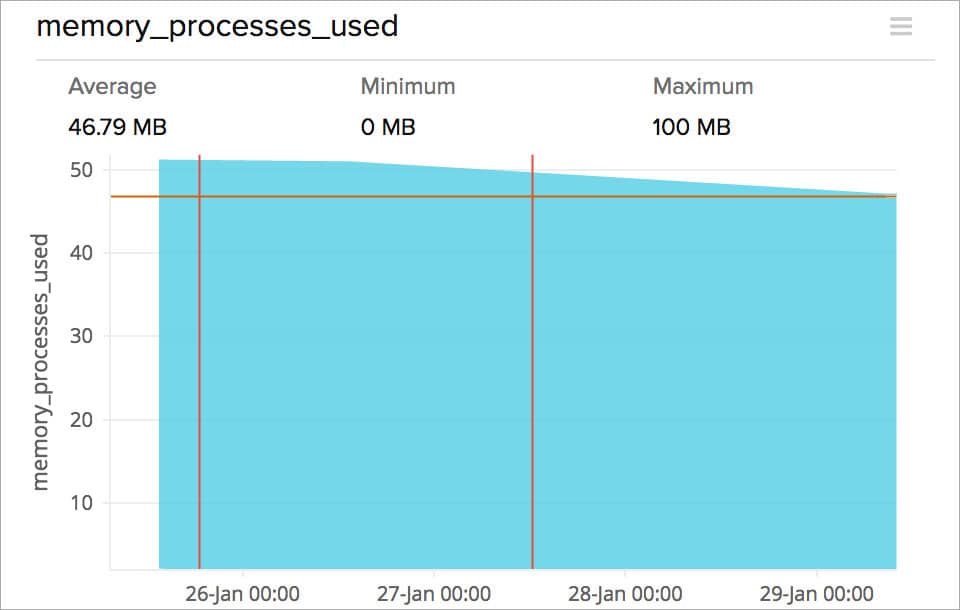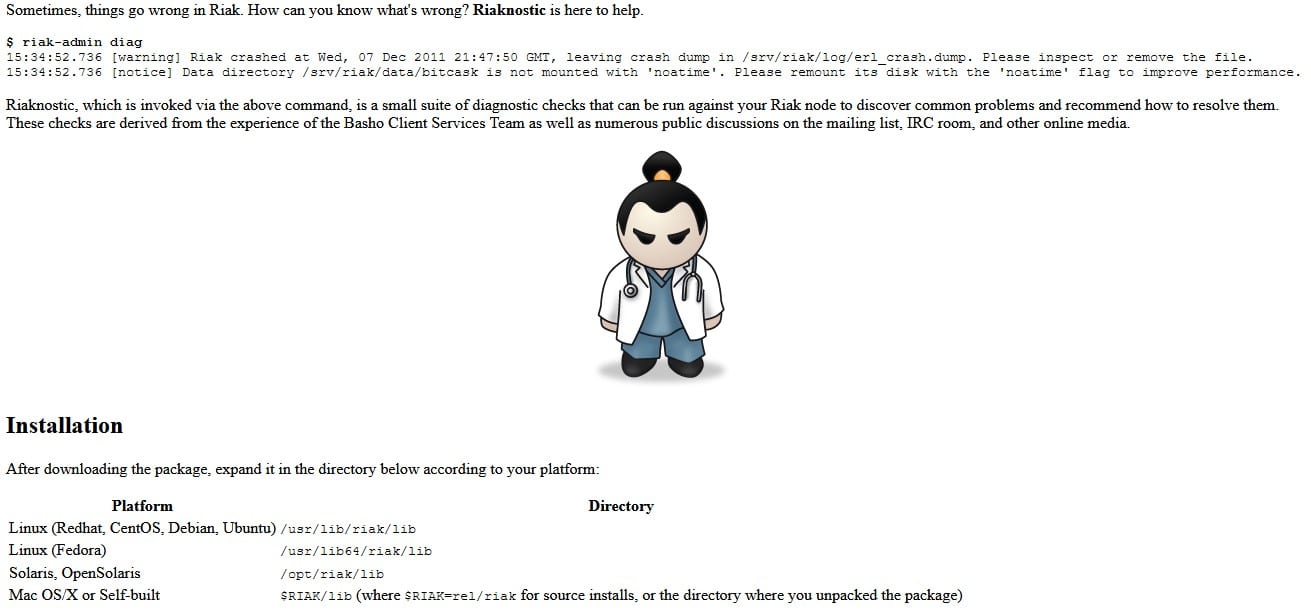We may earn a commission if you make a purchase through the links on our website.
The Best Riak Database Monitoring Tools
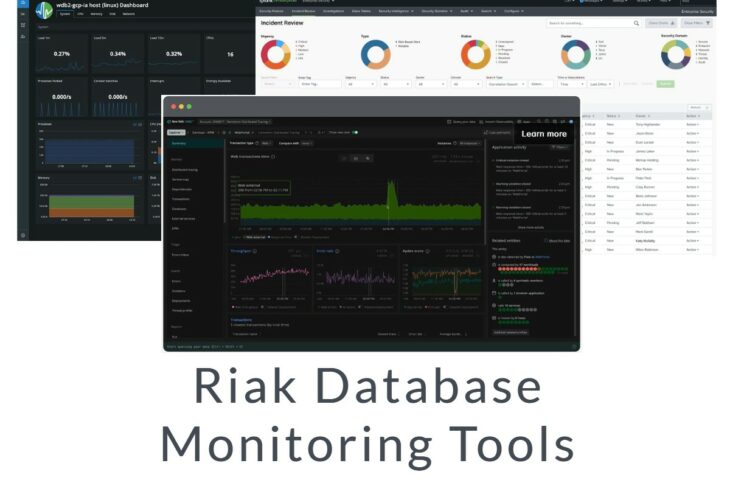
UPDATED: July 22, 2024
The success of non-relational databases is not surprising, and over the years, they have gained solid ground in the enterprise world. Riak is an open-source, web-scalable database based on NoSQL and Dynamo database systems. Basho Technologies developed it. The software has been designed for fault tolerance, high availability, and great scalability.
Riak is an extensively distributed database software that provides reliable and scalable performance in various operational environments. Riak is available in free as well as commercial versions. In addition, the software is available for several platforms, including enterprise, web, cloud, and mobile platforms.
Here is our list of the best Riak database monitoring tools:
- Site24x7 – EDITOR'S CHOICE Provides real-time insights and customizable alerts for Riak database performance.
- Circonus Comprehensive monitoring with advanced analytics and customizable dashboards.
- New Relic AI-assisted monitoring and anomaly detection for efficient data visualization.
- Splunk Superior data visualization and log aggregation with advanced cybersecurity features.
- Riaknostic Comprehensive diagnostic tool suite with expert-derived solutions.
- Riak Control Intuitive REST-driven interface for managing and monitoring Riak clusters.
- collectd High-performance, open-source metric collection with substantial extensibility.
- Ganglia Scalable monitoring designed for large, high-performance computing clusters.
- Nagios Flexible and comprehensive monitoring with extensive add-ons and robust alerting.
- OpenTSDB Scalable, precise time series database for large-scale data collection and visualization.
- Riemann Powerful stream processing language for real-time event tracking and detailed queries.
- Zabbix Comprehensive, open-source monitoring with robust security and broad monitoring range.
Explaining Riak
Riak is distributed across many nodes and is deployed without a master instance, hence, Riak is considered a fault-tolerant database. It does not have a single point of failure. Ideally designed for distributed cloud data infrastructures, Riak provides superior performance in high-volume read-and-write applications and can build cloud file systems.
The standard version of Riak is integrated with features like multi-node clustering and MapReduce. In contrast, the enterprise version is enabled with Simple Network Management Protocol (SNMP) monitoring tools, management tools, implementation, consulting services for architecture, and 24-hour technical support, along with the features provided in the standard version.
Riak has been architected for multiple advantages:
- Availability Riak replicates and retrieves data intelligently, so it is available for reading and writing operations, even in failure conditions.
- Fault tolerance You can lose access to many nodes due to network partition or hardware failure without losing data.
- Operational simplicity You can easily add new machines to your Riak cluster without incurring a larger operational burden; the same ops tasks apply to small clusters as large clusters.
- Scalability Riak automatically distributes data around the cluster and yields a near-linear performance increase as you add capacity.
Riak uses a simple key-value model for object storage. Objects in a Riak are stored in a flat namespace called a bucket, and it consists of a unique key and a value. Thus, you can virtually keep any content you want in a Riak – images, text, XML, JSON, and HTML documents; user and session data; log files; backups; and more.
Riak provides a straightforward, RESTful API as well as a protocol buffer interface. Riak has several client libraries, including Python, Java, Perl, Ruby, Erlang, PHP, .NET, and more.
Riak Variants
Riak comes in two variants: Riak KV and Riak TS. Both variants share the same Riak Core but have different use cases.
Riak KV is a scalable, highly available, and easy-to-operate distributed NoSQL database. One of the most important things is that it automatically distributes data across the cluster for fast performance and fault tolerance. What's more, Riak KV deals with Key-Value cases.
Riak TS optimizes IoT data and time series, and it also provides faster reads and writes that help makes it easier to query, analyze, and store time and location data. As a result, Riak TS forms the foundation for reducing the complexity of integrating and implementing active workloads for Big-Data, IoT, and hybrid cloud applications with the most flexible and available NoSQL database.
The Riak principle is based on Amazon's Dynamo Paper with heavy influence from the CAP Theorem. The database is written in Erlang and has fault-tolerant data replication and automatic distribution across the cluster for resilience and performance.
Essential yet straightforward Use Cases Of Riak
- For Ads Riak has repeatedly proven that it is one of the best choices for many use cases and serving advertising content is significant. Being such a popular database, Riak does content to different web and mobile users with low latency.
- For Sessions Storage Riak was initially created to serve as a scalable session store. However, the database evolved over the years and started doing as complex session storage as well. What was the reason for this evolution? Riak includes advanced features such as MapReduce, Bitcask, and others. User and session IDs are usually stored in cookies so that Riak can serve these requests with low latency. It is thus one of the most critical use cases for Riak.
- For Sensor Data Sensor data is nothing but the output of a device that detects and responds to some type of input from the physical environment. Many devices collect and send data at a given interval, and sometimes it becomes difficult to handle that data. Riak helps you in such scenarios. It is considered one of the better options for storing sensor data.
- For Log Data Log data means the information about events that occur in an OS or other software or messages between different users of communication software. One of the ordinary yet essential use cases of Riak is storing large amounts of log data, and Riak can do the same with the help of MapReduce.
- For User Account Data Every company needs to handle user account data. It is very critical for any business. Hence, companies need a simple yet effective way to store that data. In this case, Riak can be a good storage option. Each account data in Riak could be stored as a JSON object in a bucket. What's more, object keys for the data can also be used, and to retrieve data; you can use a user ID.
Riak Database Monitoring Tools
There are many self-hosted, open-source, and service-based solutions for aggregating and analyzing statistics and log data to alert, monitoring, and trend analysis on a Riak cluster. In addition, some solutions provide Riak-specific modules or plugins.
Many of the tools mentioned below were either created by third parties or Riak engineers for general usage and passed to the community for further updates. As such, many of the below only aggregate the statistics and messages output by Riak 1.4x.
Like all code under Riak labs, the below tools are “best effort tools” and have no dedicated Riak support. However, the following are solutions that community members and customers have reported success with when used to monitor their Riak clusters' operational status.
Open source and community tools are presented along with commercial and hosted services.
Hosted Service Monitoring Tools
Our methodology for selecting Riak Database Monitoring Tools:
We've broken down our analysis for you based on these key criteria:
- Scalability and Performance: Evaluating the ability of the tool to handle large-scale data and maintain performance under high loads.
- Integration and Compatibility: Assessing how well the tool integrates with Riak and other components in a typical tech stack.
- Ease of Use: Considering the user interface, ease of setup, and overall user experience.
- Alerting and Reporting: Analyzing the effectiveness of the tool's alerting mechanisms and the quality of its reporting features.
- Support and Community: Looking at the level of support provided, both from the official channels and the user community.
The following are some commercial tools for Riak database monitoring that Riak customers have reported successfully using statistics gathering and monitoring within their Riak clusters:
1. Site24x7 – FREE TRIAL
Site24x7 excels as a versatile tool for monitoring Riak databases. It combines comprehensive monitoring capabilities with real-time insights into Riak's performance and health. Customizable alerts and detailed reports ensure optimal operation and quick resolution of issues. Its adaptability extends beyond Riak to other NoSQL databases, positioning it as a robust solution for diverse systems and applications.
Key Features:
- Real-Time Monitoring: Provides live insights into Riak database performance
- Customizable Alerts: Set alerts based on specific database metrics to stay ahead of issues
- Detailed Reports: Offers in-depth analytics and reports on database health
- Easy Integration: Seamlessly integrates with Riak and other NoSQL databases
- Cluster Health Monitoring: Tracks the performance of clusters and individual nodes
Why do we recommend it?
Site24x7 is recommended for Riak database monitoring due to its comprehensive feature set that provides real-time insights and detailed analytics. This is crucial for maintaining the high availability and performance of Riak databases, especially in distributed environments.
Who is it recommended for?
This tool is ideal for database administrators and IT professionals who manage Riak databases, particularly in environments where the high availability and performance of these databases are critical.
Pros:
- Effective Real-Time Monitoring: Provides immediate insights into Riak database performance, helping maintain optimal operation
- Proactive Alerts: Customizable alerts enable proactive database management, preventing issues before they escalate
- In-Depth Reporting: Detailed analytics and reporting features aid in comprehensive database health assessments
Cons:
- Learning Curve: Users new to monitoring distributed NoSQL databases may need some time to become familiar with all features
EDITOR'S CHOICE
Site24x7 is our top choice for monitoring Riak databases due to its versatility and comprehensive features. It offers real-time insights into Riak's performance and health, ensuring quick issue resolution and optimal operation. The tool's customizable alerts and detailed reports enhance its utility, making it suitable for various systems and applications beyond just Riak. Its easy integration with other NoSQL databases solidifies its position as a robust monitoring solution.
Download: Download a 30-Day Free Trial
Official Site: https://www.site24x7.com/plugins/riak-monitoring.html
OS: Cloud-Based
2. Circonus
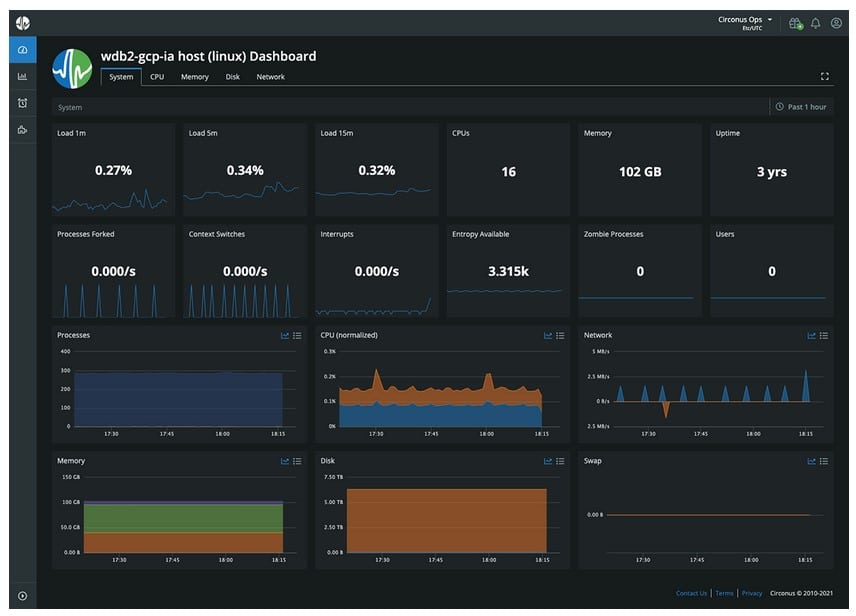
Circonus provides organization-wide monitoring, trend analysis, alerting, notifications, and dashboards. You can also use the tool to provide trend analysis and help with troubleshooting and capacity planning in a Riak cluster environment.
Key Features:
- Comprehensive Monitoring: Provides organization-wide monitoring and trend analysis
- Advanced Alerting: Offers customizable alerts and notifications to prevent downtime
- Real-Time Dashboards: Features visually appealing, highly customizable dashboards for quick insights
- Infrastructure Visibility: Monitors across on-premises, cloud, and hybrid environments for complete visibility
- Contextual Analytics: Utilizes contextual tagging and advanced analytics to reduce Mean Time to Resolution (MTTR)
Why do we recommend it?
Circonus is recommended for its comprehensive monitoring capabilities that span on-premises, cloud, and hybrid environments. Its advanced analytics and customizable dashboards make it a powerful tool for preventing issues and reducing downtime.
The tool eliminates preventable outages and downtime. Circonus also accelerates problem resolution time, deploys software faster with less risk, and consolidates monitoring solutions.
Circonus gains complete visibility into your infrastructure across on-premises, cloud, and hybrid environments. Contextual tagging, advanced analytics, and real-time intelligence help you prevent issues and reduce MTTR. Circonus also leverages dashboards, granular metrics, and data with context to quickly identify and resolve bandwidth issues and bottlenecks.
Who is it recommended for?
Circonus is ideal for large organizations that require detailed infrastructure visibility and advanced monitoring features. It is particularly useful for those needing robust support for hybrid environments and Riak clusters.
Pros:
- Highly Customizable Interface: The user interface is not only visually appealing but also highly customizable to fit specific needs
- Unified Monitoring: Offers comprehensive organizational database monitoring from a single-page view
- Versatile Monitoring Capability: Can monitor diverse environments, including cloud, on-prem, and hybrid platforms
Cons:
- Ideal for Larger Organizations: Smaller organizations may find the tool more complex and robust than needed
Website Link: https://www.circonus.com/
3. New Relic
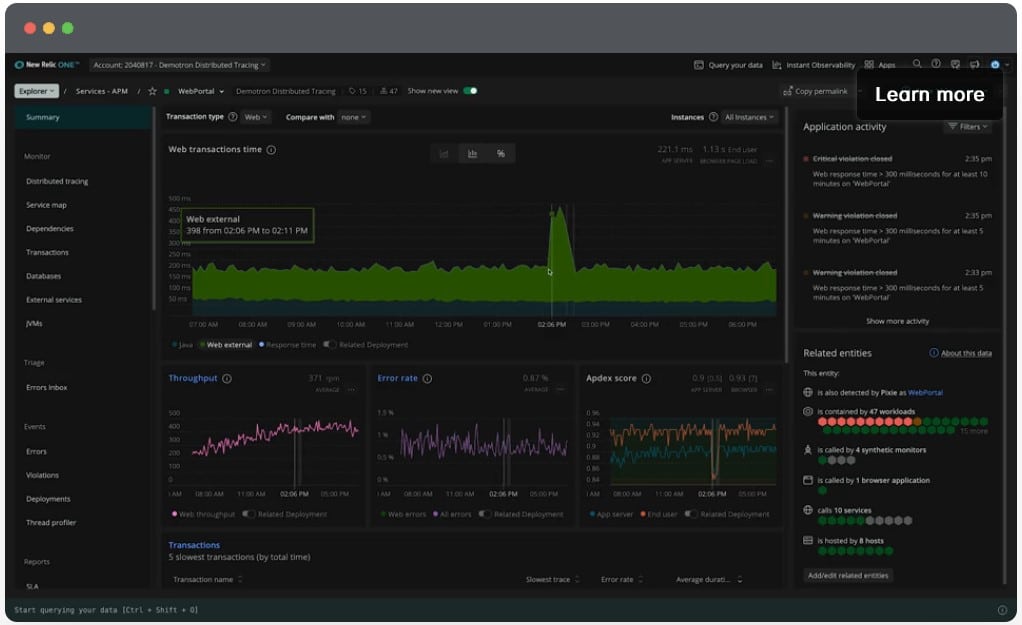
New Relic is a data analytics and visualization platform that can provide information on Riak nodes' current and past states and visualize machine-generated data such as log files.
Key Features:
- Data Analytics and Visualization: Provides insights into current and past states of Riak nodes and visualizes machine-generated data
- Unified Telemetry Collection: Collects all your telemetry in a single secure cloud, avoiding tool sprawl and data silos
- Correlate Issues: Correlates issues across your entire stack for efficient debugging and collaboration
- IDE Integration: Debug and collaborate directly from your Integrated Development Environment (IDE)
- AI Assistance: Offers AI-driven assistance throughout the monitoring process
- Riak Agent Support: Includes a Riak New Relic Agent for collecting statistics from the Riak HTTP/stats endpoint
- Anomaly Detection: Uses anomaly detection to highlight abnormal behavior, particularly in Azure environments
- Intuitive Dashboards: Simple yet intuitive admin dashboards for easy data management and visualization
Why do we recommend it?
New Relic is recommended for its powerful AI-assisted monitoring and anomaly detection capabilities. Its ability to unify telemetry data in a secure cloud environment makes it an efficient tool for data visualization and issue correlation.
New Relic collects all your telemetry in one secure cloud with no-tool sprawl or data silos. It is one connected experience and not a maze of charts. The tool can correlate issues across your entire stack and also debug and collaborate from your IDE. In addition, the new Relic provides AI assistance at every step.
A Riak New Relic Agent for collecting statistics from the Riak HTTP/stats endpoint is also available.
Who is it recommended for?
New Relic is ideal for small to medium-sized teams that need robust data analytics and visualization tools. It is particularly beneficial for those working with Azure environments and requiring AI-driven monitoring.
Pros:
- AI-Powered Monitoring: Monitors data with AI assistance, reducing false positives and enhancing accuracy
- Anomaly Detection: Identifies abnormal behavior, especially useful for monitoring Azure environments
- User-Friendly Dashboards: Features easy-to-use admin dashboards that simplify data management
Cons:
- Best for Smaller Teams: More suited for small to medium-sized teams due to its specific features and scalability
Website Link: https://newrelic.com
4. Splunk
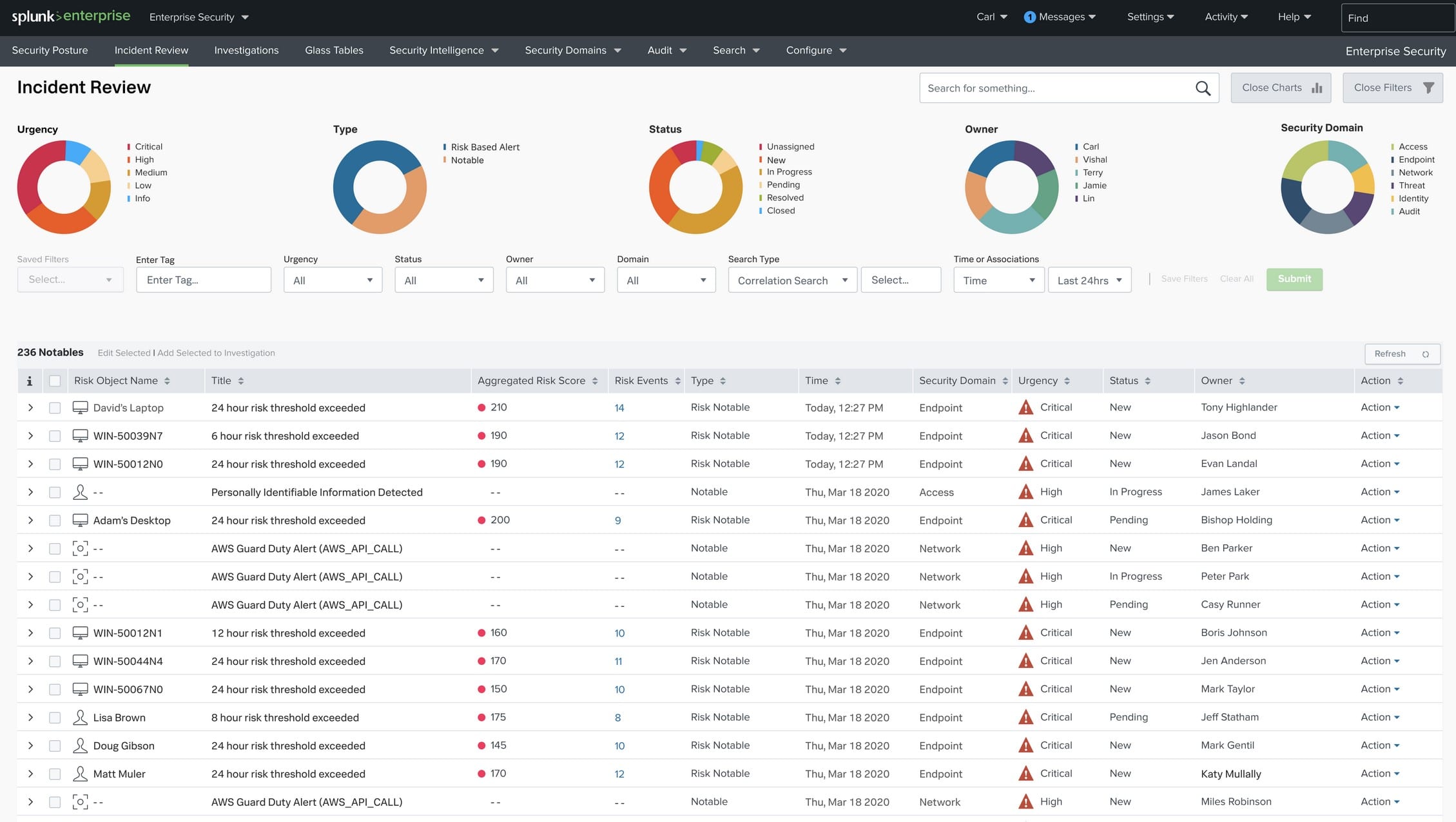
Splunk is available as downloadable software or a service and provides tools for visualization of machine-generated data such as log files. In addition, it can be connected to Riak's HTTP statistics /stats endpoint.
Key Features:
- Data Visualization: Provides powerful visualization tools for machine-generated data such as log files
- Riak Integration: Connects to Riak's HTTP statistics/stats endpoint for comprehensive data collection
- Log Aggregation: Aggregates operational log files from Riak cluster nodes, including OS and Riak-specific logs
- Real-Time Graphing: Enables real-time graphing, search, and visualizations for effective troubleshooting and trend analysis
- Cybersecurity Solutions: Recognized as a SIEM leader by Gartner, enhancing cybersecurity with advanced features
- Fraud Risk Reduction: Lowers data breaches and fraud risks by 70% using the Splunk AIOps platform
- Incident Reduction: Reduces incidents and downtime by 82%, ensuring smoother operations
- Comprehensive Data Access: Brings data to every decision-making process across the organization
Why do we recommend it?
Splunk is recommended for its superior data visualization and comprehensive log aggregation capabilities. Its recognition as a SIEM leader and its ability to significantly reduce incidents and downtime make it a powerful tool for enterprises.
You can use Splunk to aggregate all Riak cluster node operational log files, including the operating system and Riak-specific logs and Riak statistics data. This data is then available for real-time graphing, search, and other visualizations ideal for troubleshooting complex issues and spotting trends.
Splunk Cybersecurity Solutions is ranked as a SIEM leader in Gartner's Magic Quadrant for the eighth time. The tool lowers data breaches and other fraud risks by 70%, and Splunk also reduces incidents and downtime by 82% with the Splunk AIOps platform. In addition, Splunk brings data to every question, decision, and action across your organization.
Who is it recommended for?
Splunk is ideal for large enterprises needing advanced data visualization and cybersecurity solutions. It's particularly useful for organizations looking to integrate extensive logs and statistics into their monitoring and decision-making processes.
Pros:
- Excellent Visuals: Uses high-quality visuals to display collected data and insights, making it easy to understand and analyze
- Versatile Data Collection: Supports a wide range of environments for comprehensive data collection
- Machine Learning: Utilizes machine learning to identify new data sources and monitor behavior effectively
- Enterprise Support: Caters to large enterprises with robust support and extensive integrations
Cons:
- Enterprise-Focused Features: Many features and services are tailored specifically for large enterprise networks
Website Link: https://www.splunk.com/
Self-hosted monitoring tools for Riak
5. Riaknostic
Riaknostic is a growing suite of diagnostic checks that you can run against your Riak node to discover common problems and recommend solving them. These checks are derived from the experience of the Riak Client Services Team and several public discussions in the IRC room, mailing list, and other online media.
Key Features:
- Diagnostic Checks: Runs a suite of diagnostic checks on your Riak node to identify common problems
- Expert-Derived Solutions: Checks are based on the experiences of the Riak Client Services Team and community discussions
- Admin Command Integration: Integrates seamlessly into the riak-admin command via the diag subcommand
- Troubleshooting Support: Provides significant assistance in diagnosing and troubleshooting issues on Riak nodes
Why do we recommend it?
Riaknostic is recommended for its comprehensive suite of diagnostic tools and expert-derived solutions. Its integration with the riak-admin command makes it an essential tool for troubleshooting Riak nodes.
Riaknostic integrates into the riak-admin command via a diag subcommand and is a significant initial step in the process of diagnosing and troubleshooting issues on Riak nodes.
Who is it recommended for?
Riaknostic is ideal for system administrators and developers working with Riak who need reliable diagnostic tools and expert recommendations for problem-solving.
Pros:
- Comprehensive Tool Suite: Includes a variety of tools to diagnose issues effectively
- Expert Insights: Leverages the expertise of the Riak Client Services Team for reliable problem-solving
- Command Integration: Integrates smoothly with the base riak-admin command, enhancing usability
Cons:
- Improvement Needed in Documentation: Documentation could be more detailed and user-friendly
Website Link: http://riaknostic.basho.com/
6. Riak Control
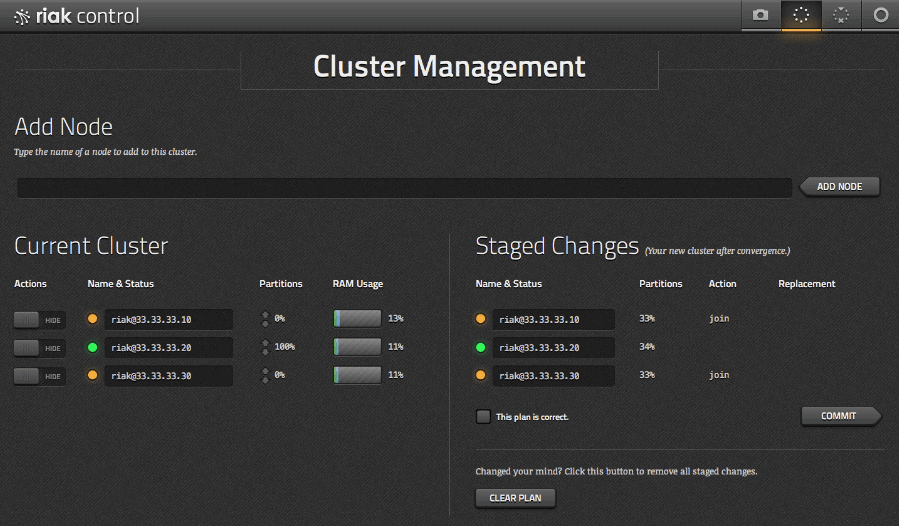
Riak Control is Riak's REST-driven user interface for managing Riak clusters. It is designed to give you a quick insight into the health of your cluster and allow for easy management of nodes. In addition, it is a web-based administrative console for inspecting and manipulating Riak clusters.
Key Features:
- REST-Driven Interface: Provides a REST-driven user interface for managing Riak clusters
- Cluster Health Insight: Offers quick insights into the health of your cluster
- Node Management: Allows for easy management and manipulation of nodes within the cluster
- Web-Based Console: Features a web-based administrative console for inspecting Riak clusters
- Pre-Integrated Code: Comes pre-integrated with versions of Riak 1.1 and above, requiring no additional installation steps
- Security Configuration: Requires SSL and HTTPS configuration for secure access
- Immediate Health Feedback: Provides immediate insight into overall cluster health, node status, and handoff operations
Why do we recommend it?
Riak Control is recommended for its intuitive and efficient interface that simplifies cluster management. Its ability to provide quick insights into cluster health and node status makes it an essential tool for managing Riak environments.
Though Riak Control is maintained as a separate application, the necessary code ships with versions of Riak 1.1 and above and requires no additional installation steps. Riak Control is disabled by default if Riak authentication is enabled. It is strongly recommended that SSL and HTTPS be configured and enabled for accessing Riak Control. Ensure to restart the node once you have enabled Riak Control for the changes to take effect.
While Riak Control does not currently offer specific monitoring and statistics aggregation or analysis functionality, it offers features that provide immediate insight into the overall cluster health, node status, and handoff operations.
Who is it recommended for?
Riak Control is ideal for administrators managing large Riak databases who need a reliable tool for cluster health monitoring and node management. Its REST-driven interface and comprehensive metrics make it especially useful for larger deployments.
Pros:
- Intuitive Interface: Features a user-friendly interface that enhances cluster management
- Efficient API Use: Utilizes an efficient REST API for streamlined operations
- Single-Pane Monitoring: Allows monitoring of multiple metrics from a single pane, improving visibility
Cons:
- Best for Larger Databases: More suited for larger Riak databases due to its advanced features and capabilities
Website Link: https://riak.com/riak-1-4-riak-control/
7. collectd
collectd gathers statistics about the system it is running on and stores them. It collects metrics from various sources like the operating system, applications, log files, and external devices and stores this information or makes it available over the network. The statistics are then graphed to find current performance bottlenecks, predict system load, and analyze trends.
Key Features:
- Comprehensive Metric Collection: Gathers metrics from the operating system, applications, log files, and external devices
- High Performance: Written in C for performance and portability, ideal for systems without a scripting language or cron daemon
- Extensive Metric Handling: Optimized to handle hundreds of thousands of metrics efficiently
- Powerful Networking: Offers robust networking features for data transmission and collection
- Extensible Architecture: Highly extensible, allowing for customization and integration with various plugins
- Active Development: Continually developed, supported, and well-documented
Why do we recommend it?
collectd is recommended for its robust performance and comprehensive metric collection capabilities. Its extensibility and active development make it a reliable choice for system monitoring.
Certain factors set collectd apart from similar free, open-source projects. For one, it is written in C for performance and portability, allowing it to run on systems without a scripting language or cron daemon, such as embedded systems. The tool also includes optimizations and features to handle hundreds of thousands of metrics. It also provides powerful networking features and is extensible in numerous ways.
Last but not least, collectd is actively developed, supported, and well documented. However, collectd does not generate graphs, and monitoring functionality has only been added in version 4.3 but is limited to simple threshold checking.
Who is it recommended for?
collectd is ideal for system administrators and developers looking for a free and open-source solution to gather and analyze system metrics. It's particularly useful for those requiring a high-performance tool that runs on diverse systems, including embedded environments.
Pros:
- Diverse Metric Sources: Collects metrics from the OS, applications, log files, and other sources, providing comprehensive system insights
- Free and Open Source: Completely free and open-source, promoting transparency and community contributions
- Efficient Performance: Written in C for optimal performance and portability across different systems, including embedded ones
Cons:
- Small Community: Lacks a large user community, which can impact the availability of support and resources
8. Ganglia
Ganglia is a monitoring system specifically designed for large, high-performance computers, such as clusters and grids. Community members and customers using Riak have reported success in using Ganglia to monitor the Riak database.
Key Features:
- Cluster Monitoring: Specifically designed for monitoring large, high-performance computing systems such as clusters and grids
- Hierarchical Design: Utilizes a hierarchical design to federate clusters efficiently
- Open Source: BSD-licensed and open-source, encouraging community contributions and transparency
- Data Representation: Uses XML for data representation, ensuring portability and simplicity
- Efficient Data Transport: Employs XDR for compact and efficient data transport
- Data Storage and Visualization: Leverages RRD tool for storing and visualizing data
- Low Overhead: Features carefully engineered data structures and algorithms for low per-node overhead and high concurrency
- Wide OS Support: Robust implementation that supports a vast array of operating systems and processor architectures
- Scalability: Can scale to handle clusters with up to 2000 nodes, making it ideal for large deployments
Why do we recommend it?
Ganglia is recommended for its robust design and scalability, making it perfect for monitoring large, high-performance clusters. Its use of familiar technologies like XML and RRD tool ensures efficient data management and visualization.
Ganglia is a BSD-licensed open source project based on a hierarchical design targeted at the federation of clusters. It leverages widely used technologies such as XML for data representation, portable data transport, XDR for compact, and RRD tool for data storage and visualization. Furthermore, it uses carefully engineered data structures and algorithms to achieve low per-node overheads and high concurrency.
The implementation of Ganglia is robust, has been ported to an extensive set of operating systems and processor architectures, and is presently in use on thousands of clusters worldwide. Ganglia has been used to link clusters across university campuses globally and can scale to handle clusters with 2000 nodes.
Who is it recommended for?
Ganglia is ideal for enterprises and research institutions managing large-scale Riak deployments. It is particularly beneficial for those needing a scalable monitoring solution capable of handling thousands of nodes.
Pros:
- Enterprise Focus: Designed for large deployments, making it suitable for enterprise use and extensive monitoring needs
- Scalability: Capable of scaling to support clusters with up to 2000 nodes
- Simple Data Export: Exports data in simple XML format for ease of use and integration
Cons:
- Best for Large-Scale Use: More suited for wide scale Riak deployments, which may be overkill for smaller setups
Website Link: http://ganglia.sourceforge.net/
9. Nagios
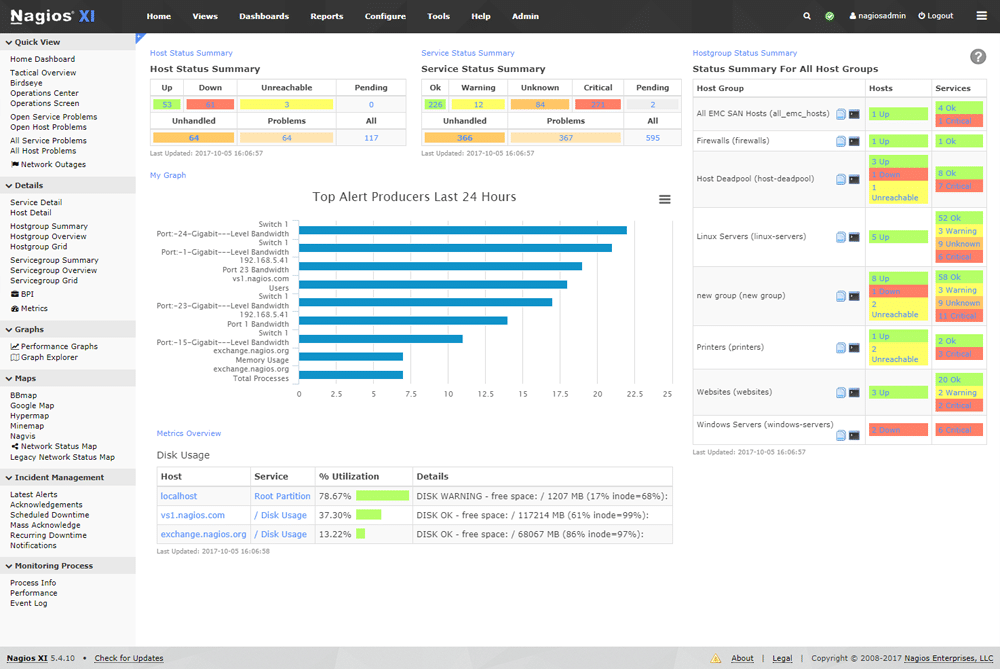
Nagios is an alerting and monitoring solution that can provide information on the status of the Riak cluster nodes and various types of alerts when particular events occur. Nagios also offers logging and reporting of events and can be used for identifying trends and capacity planning.
Key Features:
- Status Monitoring: Provides detailed information on the status of Riak cluster nodes and alerts for specific events
- Event Logging and Reporting: Offers comprehensive logging and reporting of events to help identify trends and plan capacity
- Server Monitoring: Known for its superior server monitoring capabilities with both agent-based and agentless options
- Extensive Add-Ons: Supports over 5000 different add-ons available through the Nagios Exchange community
- Flexible Alerting: Supports a wide range of alerting options including SMS and email notifications
- API Integration: Features a robust API backend for developers to integrate custom applications
Why do we recommend it?
Nagios is recommended for its robust monitoring and alerting capabilities, extensive add-ons, and flexible alerting options. Its open-source nature and strong community support make it a versatile and powerful tool for server and application monitoring.
Nagios is known for being one of the best server monitoring tools on the market. It makes server monitoring easy because of the flexibility to monitor your servers with both agent-based and agentless monitoring. With over 5000 different add ons available to monitor your servers, the community at the Nagios Exchange has left no stone unturned.
Who is it recommended for?
Nagios is ideal for IT administrators and developers who need a flexible and comprehensive monitoring solution. It's especially suitable for those who can handle a technical installation process and want to customize their monitoring setup with numerous add-ons and API integrations.
Pros:
- Transparent Open Source: Fully open-source, promoting transparency and community-driven improvements
- Informative Interface: Features a simple yet informative interface that enhances user experience
- Flexible Alerting Options: Provides flexible alerting options, supporting both SMS and email notifications
- Developer-Friendly API: Robust API backend makes it ideal for developers who want to integrate custom applications
- Generous Trial Period: Offers a very generous two-month trial period for users to evaluate the product
Cons:
- Support Limitations: Open-source version lacks the quality support that is available with paid products
- Complex Installation: Installation process can be technical and complex, requiring advanced knowledge
Website Link: https://www.nagios.org/
10. OpenTSDB
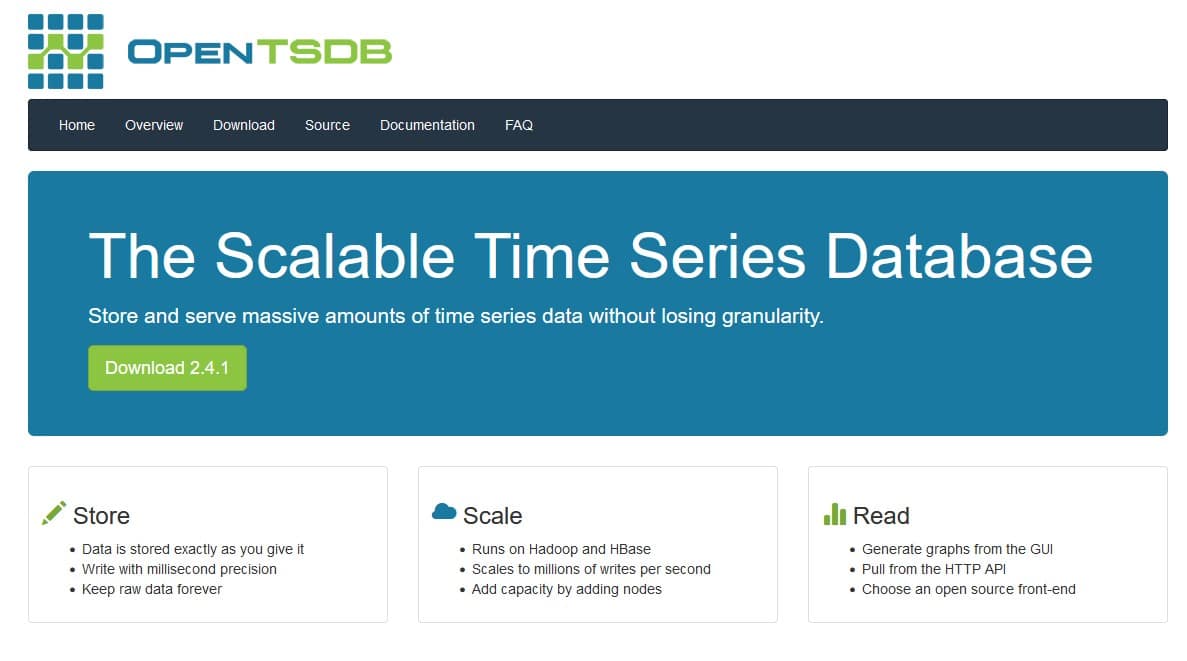
OpenTSDB is a scalable, distributed Time Series Database (TSDB) used to store, index, and serve metrics from various sources. It can collect data at a large scale and graph these metrics on the fly.
Key Features:
- Scalable Time Series Database: Designed to store, index, and serve metrics from various sources with high scalability
- High Precision Storage: Stores data with millisecond precision, maintaining granularity
- Raw Data Retention: Keeps raw data indefinitely, allowing for detailed analysis
- Hadoop and HBase Integration: Runs on Hadoop and HBase, enabling it to scale to millions of writes per second
- Node Expansion: Easily adds capacity by adding nodes to the system
- Native Graphing: Generates graphs directly from the GUI for real-time data visualization
- Riak Collector Integration: Includes a Riak collector as part of the collector framework for seamless data collection
Why do we recommend it?
OpenTSDB is recommended for its ability to handle and store large-scale time series data with high precision. Its integration with Hadoop and HBase ensures scalability, and native graphing capabilities provide immediate data visualization.
OpenTSDB stores and serves a massive amount of Time Series Data without losing granularity. Data is stored the way you give it. You can write it with millisecond precision, and you can keep raw data forever.
As for scalability, OpenTSDB runs on Hadoop and HBase and scales to millions of writes per second. The tool adds capacity by adding nodes, and you can also generate graphs from the GUI. In addition, a Riak collector for OpenTSDB is available as a part of the collector framework.
Who is it recommended for?
OpenTSDB is ideal for organizations needing a scalable and precise time series database for large-scale data collection and analysis. It's particularly beneficial for those who require detailed raw data retention and native graphing capabilities.
Pros:
- Large-Scale Data Handling: Capable of collecting and storing vast amounts of data on the fly, suitable for high-scale environments
- Native Graphing Support: Provides native support for generating graphs from collected metrics
- Detailed Data Review: Supports raw data review and processing, allowing for in-depth analysis
Cons:
- Graphing Limitations: Graphing features could be more advanced and user-friendly
Website Link: http://opentsdb.net/
11. Riemann
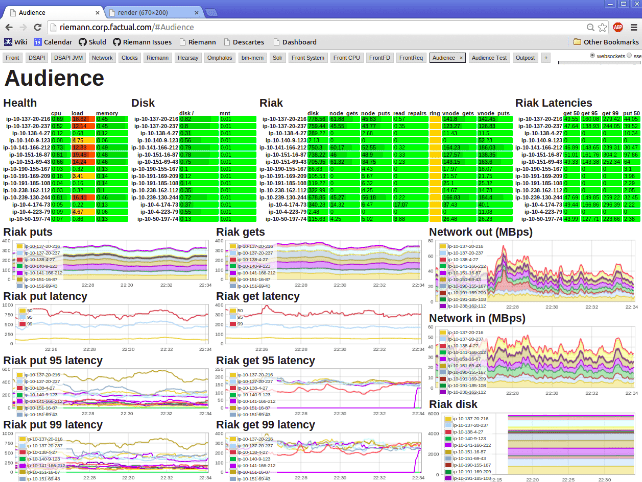
Riemann uses a powerful stream processing language to aggregate events from client agents running on Riak nodes and can help track trends or report on events as they occur. Statistics can be gathered from your nodes and forwarded to a solution such as Graphite for producing related graphs.
Key Features:
- Stream Processing Language: Utilizes a powerful stream processing language to aggregate and analyze events from client agents on Riak nodes
- Trend Tracking: Helps track trends and report on events as they occur in real-time
- Node Statistics: Gathers statistics from Riak nodes and forwards them to other solutions like Graphite for graph production
- Riemann Tools Project: Includes small programs specifically designed to send data to Riemann, with a module for reading Riak statistics
Why do we recommend it?
Riemann is recommended for its powerful stream processing capabilities and real-time event tracking. Its ability to gather detailed statistics from Riak nodes and forward them to visualization solutions makes it a versatile monitoring tool.
A Riemann Tools project consisting of small programs for sending data to Riemann provides a module specifically designed to read Riak statistics.
Who is it recommended for?
Riemann is ideal for small to medium-sized database environments where detailed querying and real-time event tracking are crucial. It is particularly useful for those who can leverage external platforms for data visualization.
Pros:
- Detailed Queries: Uses a stream processing language for creating detailed and specific queries
- Well Documented: Offers good documentation and support for users
- Ideal for Smaller Databases: Suited for small to medium-sized databases, providing efficient monitoring and analysis
Cons:
- Requires External Visualization: Insights and data must be sent to another platform, such as Graphite, for visualization
Website Link: https://riemann.io/
12. Zabbix
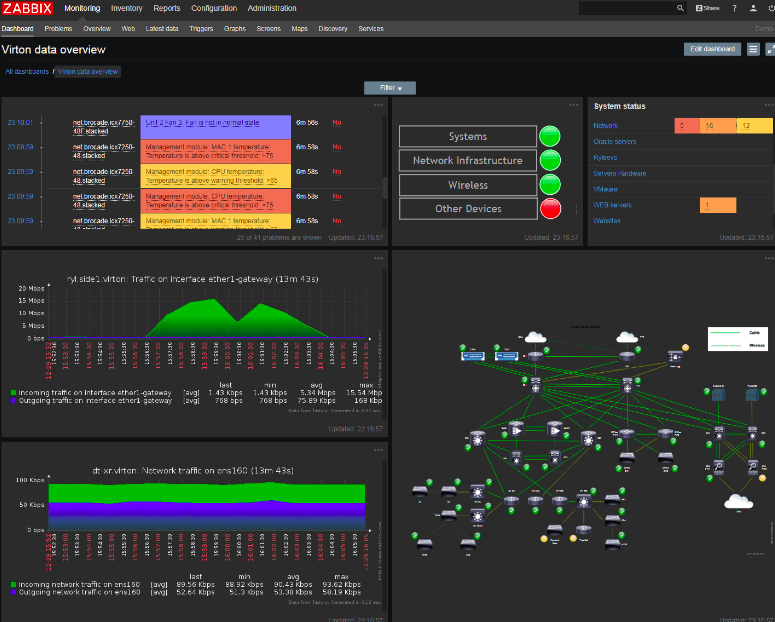
Zabbix is an open-source performance monitoring, alerting, and graphing solution that can provide information on the state of Riak cluster nodes. With the flexibility of deployment options, you are still entirely in control of your data.
Key Features:
- Performance Monitoring: Provides detailed monitoring and alerting for the state of Riak cluster nodes
- Flexible Deployment: Allows for deployment and scaling of a distributed infrastructure from a central web UI
- Native Encryption: Supports native encryption between all components to ensure data security
- External Vault: Stores sensitive information in an external vault for added security
- Global Support: Backed by over 250 global partners and external vendors for enterprise-level support
- High Availability: Ensures 24/7 uptime and minimizes the risk of data loss with high availability solutions
Why do we recommend it?
Zabbix is recommended for its comprehensive monitoring and robust security features. Its ability to detect new devices and configuration changes immediately and the support of multiple notification methods make it a reliable tool for performance monitoring.
Zabbix allows you to deploy and scale a distributed infrastructure from a central web UI with native encryption support between all of the components. It is very secure and safe, and Zabbix keeps your sensitive information secure by storing it in an external vault.
Backed by 250+ global partners and multiple external vendors, Zabbix delivers enterprise-level monitoring and support to customers all over the globe. In addition, it ensures 24/7 uptime and negates the risk of data loss for your Zabbix infrastructure with high availability solutions.
Who is it recommended for?
Zabbix is ideal for organizations looking for a secure and flexible open-source monitoring solution. It is especially suitable for enterprises needing broad monitoring capabilities and high availability for their infrastructure.
Pros:
- Transparent Open Source: Fully open-source, offering transparency and community-driven development
- Broad Monitoring Range: Utilizes SNMP and ICMP for a wide range of monitoring capabilities
- Immediate Detection: Can detect new devices and configuration changes immediately, ensuring up-to-date monitoring
- Useful Templates: Offers templates for quick and easy insights into monitoring metrics
- Robust Notification System: Supports multiple notification methods, including SMS, email, custom scripts, and webhooks
Cons:
- Interface Usability: The interface is not as user-friendly or intuitive as some competitors like DataDog or Site24x7.
- Alerting Improvements Needed: Could benefit from improved alerting features to reduce false positives.
Website Link: https://www.zabbix.com/integrations/riak
Riak Monitoring – The Final Say
Riak database supports massive data storage and management with increased flexibility, availability, scalability, and fault tolerance compared to traditional databases. The performance of the databases defines the success of organizations in providing a 24X7 level of customer satisfaction and smooth operations of day-to-day business activities.
Riak Database Monitor helps you monitor the performance of the database and provides extensive information so that you can take the necessary steps before a breakdown of vital business processes occurs.
Data in today's world is one of the most crucial factors for any business. And as the amount of data generation increases significantly, the concern about reliable storage is also skyrocketing. While there are many databases available, Riak seems to be one of the first choices for many organizations, even though it has been a long since it was released.
